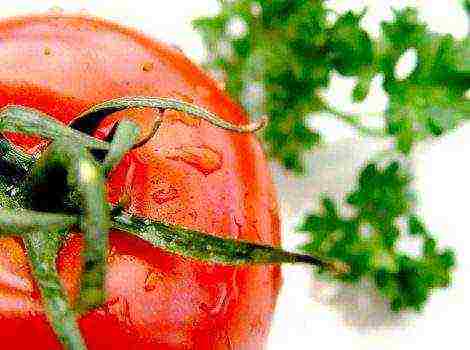Content
- 1 Apricot Parrot
- 2 Blue Diamond
- 3 Blue Heron
- 4 Brigitta (Brigitta, Brigitte)
- 5 Gander's Rhapsody
- 6 Hamilton (Hamilton)
- 7 Hemisphere
- 8 Lucky Strike
- 9 Madison Garden
- 10 White Elegance
- 11 What is forcing tulips and what are the ways
- 12 Description of the two growing methods
- 13 Where and what to buy for forcing bulbs
- 14 Selection of varieties
- 15 Soil preparation and planting containers
- 16 Tulip varieties - New Dutch
- 17 Ideal for forcing varieties - Darwin hybrids and Triumph
- 18 Fringed tulips
- 19 Double tulips - early and late varieties
- 20 Low-growing tulips or dwarf
While fresh flowers can always be bought at a flower shop, making your own tulips is a special treat. To your attention - tulip varieties that are ideal for home cultivation.
Self-grown flowers that adorn the windowsill in winter or early spring - what else can also cheer you up in cold cloudy weather? Forcing tulips by March 8, Valentine's Day or even New Year's is not as difficult as it seems.
First, a little theory. One of the most important steps in forcing tulips is chilling. The container with the planted bulbs is placed in a cool place with an air temperature of 5-9 ° C so that the tulip goes through the so-called G (Ji) stage, during which the main parts of the plant are formed. The time it takes for the buds to bloom depends on how long the plant needs to cool down, and the duration of this period differs from species to species.
To calculate in what numbers to plant tulip bulbs for distillation, subtract about 13-19 weeks (cooling time) from the desired flowering date, plus another 3-4 weeks. Typically, tulip bulbs are planted for distillation in early to mid-October.
We have selected the most interesting tulip varieties suitable for distillation, and now we will tell you about them. Read and choose!
Apricot Parrot
| Class | Plant height | Color of petals | Cooling time (weeks) |
| Parrot | up to 70 cm | Apricot | 15-16 |
It seems as if in the bud of this tulip you can see all the shades of the sunset sky: apricot rays are beautifully scattered over as if ruffled petals. Such an unusual flower shape is a sign of the Parrot class. An interesting feature of "parrots" - their petals can be of almost any shape, except for the classic: wavy, twisted, split, crumpled. "Apricot parrot" will surely appeal to fans of exotic.
Blue Diamond
| Class | Plant height | Color of petals | Cooling time (weeks) |
| Terry | up to 40 cm | Purple violet | 15-16 |
The neatly formed double satin petals of the "blue diamond" (as the name of the variety is translated) look bright and bold. The deep color is mesmerizing, it is difficult to look away from it. Terry tulips are called peony tulips because their petals are layered on top of each other, forming a bud, similar to a peony flower. Blue Diamond is equally good for forcing and growing in a flower garden.
Blue Heron
| Class | Plant height | Color of petals | Cooling time (weeks) |
| Fringed | up to 60 cm | Lilac purple | 18-19 |
Members of the Fringed class have many fans. This is not surprising, because the petals, fringed with fringe, look like they are covered with hoarfrost. The shape of the petals of the Blue Heron tulip evokes associations with the silhouette of a heron (moreover, “blue heron” is a literal translation of the name of this variety). The shade goes from dark purple at the base of the bud to light purple at the edges of the petals.
Brigitta (Brigitta, Brigitte)
| Class | Plant height | Color of petals | Cooling time (weeks) |
| Triumph | up to 50 cm | Yellow with red "blush" | 13-14 |
This variety belongs to the popular Triumph class. Typical features of the representatives of Triumph: a clear goblet shape of the bud and a strong, high peduncle. This variety is no exception. The unusual coloring of Bridgette evokes the idea of a girlish blush: the petals resemble the flushed cheeks of a young modest girl.
Gander's Rhapsody
| Class | Plant height | Color of petals | Cooling time (weeks) |
| Triumph | up to 50 cm | Soft pink | 13-14 |
Tulips of this variety tend to change color over time. At first, only light streaks are visible in the deep pink bud. Then the base of the petal becomes milky white, and a little higher there are pink blotches, resembling small splashes. Gunders Rhapsody is suitable for those who prefer restraint and sensuality at the same time.
Hamilton (Hamilton)
| Class | Plant height | Color of petals | Cooling time (weeks) |
| Fringed | up to 80 cm | Bright yellow | 16-17 |
Yellow tulips are by no means the messengers of separation. The sun color affects a person extremely favorably: it is the color of optimism, energy, love of life. The variety of this fringed tulip bears the name of Lady Hamilton, a scandalous beauty who lived in Great Britain in the 18th and 19th centuries. Bright buds with fringed petals look impressive and never go unnoticed, like the famous British woman.
Hemisphere
| Class | Plant height | Color of petals | Cooling time (weeks) |
| Triumph | up to 70 cm | White with pink strokes | 15-16 |
The Hemisphere tulip is the embodiment of tenderness and at the same time changeability. This is a chameleon flower. Look at its amazing color: at first, milky-white petals are covered with gradually emerging pale pink strokes, as if left by the brush of an unknown artist. Later, the bud begins to darken and turns dark pink.
Lucky Strike
| Class | Plant height | Color of petals | Cooling time (weeks) |
| Triumph | up to 60 cm | Red with white border | 13-14 |
Those who love contrasting color combinations (in this case, active red and snow-white) will surely appreciate the Lucky Strike tulip variety. The classic shape of the bud, inherent in all representatives of the Triumph class, does not look too strict due to the variegated color of the petals. The peculiarity of the variety is that the bud does not fully open during flowering.
Madison Garden
| Class | Plant height | Color of petals | Cooling time (weeks) |
| Fringed | up to 50 cm | Raspberry pink with yellowish fringes | 16-17 |
This tulip variety bears the name of the famous New York sports complex, which has become a venue for iconic sports events and concerts of world famous show business stars. Madison Garden tulips, graceful and solemn at the same time, with their unusual fringed petals resemble a bright stage costume of the artist. If you want a holiday in your heart, be sure to try growing these tulips!
White Elegance
| Class | Plant height | Color of petals | Cooling time (weeks) |
| Lily-colored | up to 60 cm | Creamy white | 15-16 |
A distinctive feature of the lily-colored class, as it is not difficult to guess, is the similarity of shape with a lily bud. The White Elegance tulip is really elegant and looks very noble. The ivory-colored petals are pointed at the ends and look like miniature daggers. If you are an adherent of rigor and stylish solutions, decorate the interior of the apartment by growing such a tulip at home.
Having told about the varieties of tulips that are ideal for forcing, we, of course, cannot ignore the very technology of this fascinating process. Especially for you - our master class on forcing tulips at home:
Forcing tulips for the purpose of selling is profitable only if the amount of substandard “goods” does not exceed 5, maximum 10%. If, with good care and adherence to all agrotechnical rules, the percentage of marriage in the end turns out to be much higher than the indicated figures, then the reason for this is most likely the wrong choice of planting material. In order for the tulip business to be successful, a novice florist entrepreneur needs to find out in advance which varieties of these ephemeroids are suitable for distillation (photos, names and descriptions of the best of them are presented in this article).
The best varieties for forcing: general recommendations for choosing
Unlike garden flowers, which are freely placed on sunny, blown by the breeze flower beds, greenhouse tulips grow in close quarters and stuffiness, with insufficient natural light. In such unfavorable conditions, only the healthiest and most unpretentious plants can form strong flower stalks and large buds, therefore, for flower growers engaged in forcing tulips for commercial purposes, the main criteria for choosing a planting material are the unpretentiousness and disease resistance of the variety.
Attention! Varieties of four classes of tulips belonging to the Gesner group (green-flowered, lily-colored, Rembrandt and parrot tulips) and Darwin's hybrids, due to the weakness of their peduncles and some other specific features, are of little use for forcing at home!
In addition to the above qualities, you should also pay attention to:
- decorativeness (color, size and shape) of tulip rims;
- the duration of the preservation of the cut buds;
- biological characteristics of the class to which the variety belongs;
- possible terms of receiving flowers.
Tulips "Christmas Marvel"
To accumulate biologically active substances necessary for growth and flowering, tulip bulbs need to stay in the cold for a certain time. The length of this mandatory cooling period varies significantly between cultivars. Depending on this parameter, tulip varieties are subdivided into:
- early ones - capable of blooming for the New Year holidays;
- medium - having the opportunity to dissolve the buds for Valentine's Day;
- late - long-accumulating forces, suitable for distillation by March 8.
Advice. When buying bulbs for forcing, look at their caliber. The best flowers are obtained from elite planting material with a diameter of more than 40 mm.
Varieties for early and mid forcing
"Christmas Marvel" - according to the garden classification refers to simple early tulips. Due to the fact that the bulbs of this old English variety require a short chilling, its flowers can be distilled by Christmas. Corollas "Marvel" - goblet, rather large. The petals are cold deep pink. From the inside, the bottom of the flower is yellow, outlined with a thin white border.
Cooler Cardinal is a classic variety with low, powerful and strong peduncles. The elongated goblet corollas of this early simple tulip are painted in the same rich scarlet color as the robes of the cardinals.
"Monsella" is a very unpretentious early terry variety, notable for the fact that on each of its stems there are 2 or even 3 buds. Golden, decorated with scarlet strokes, multi-petal corollas "Monsella" look very elegant and do not fade for a long time after cutting.
"Verona" is a very early, undersized variety of double tulips, the flowers of which are so lush and beautiful that at first glance they can be mistaken for vanilla yellow roses or cream peonies.
Tulips "Epricot Beauty"
"Ruby Red" - a classic of the genre, tulips with medium length, powerful flower stalks, crowned with large, goblet crimson buds. After cutting, the flowers of this variety retain their shape for a long time and do not fade.
"Flair" is a medium-sized early variety with very bright, catchy flowers. The shape of the "Flair" buds is traditional, goblet, but due to the fact that their fiery-scarlet petals are decorated with a wide golden border, tulips look extremely elegant.
"Prince Carnival" is one of the most disease-resistant and beautiful simple varieties. The canary-yellow, pointed petals of the flowers of the "Prince" are covered with "torn" scarlet stains from below, which gives the impression that the corolla of tulips are engulfed in tongues of flame.
Epricot Beauty is a masterpiece variety that has been at the top of various flower charts for many years and is in high demand in the market. Emitting a delicate aroma, elegant large corollas of this tulip are painted in salmon pink or pale peach color. The bottoms of Epricot Beauty flowers are creamy white, edged with a thin lemon-yellow border.
"Black Jack" is an exotic variety, whose corollas are painted in such a rich dark purple color that they seem black from afar. Peduncles at "Jack" are powerful and rather high (45-60 cm). In addition to the unusual color of the petals, the variety is notable for the fact that after cutting its buds do not fade for a long time and retain their shape.
Tulips "Abu Hasan"
Ronaldo is another non-trivial tulip with large, goblet, bright purple flowers. "Ronaldo" is very unpretentious, and therefore in any conditions gives the highest quality distillation.
"Abu Hasan" is a very beautiful medium-sized Dutch variety with buds of unusual color for tulips. Crimson-chocolate, with a wide ocher-yellow border, "Hasan" petals are similar in color to autumn maple leaves.
Late forcing varieties
"Alexander Pushkin" is a variety with strong, medium-height peduncles and large cup-shaped corollas. The tulip petals are painted in a warm purple color and decorated with a thin snow-white border.
"Barcelona" is a variety from the "classics of the genre" series. Tulips with tall, sixty-centimeter flower stalks, on which lilac-pink goblet buds proudly rest.
White Dream is another classic Dutch variety with large, creamy white corollas.
Tulips "Tom Paus"
"Hunter" is a variety without any frills. Tulips with bright scarlet buds and powerful long stems are ideal for cutting.
"Tom Paus" is a very elegant, "festive" variety, with bright large corollas and tight erect peduncles. Petals "Tom" are two-colored - coral pink at the tips and orange-golden at the bases.
"Menton" is a variety from the category of simple late tulips. Dense, conical buds of "Menton" are painted in a delicate warm pink color, smoothly turning to the edges of the petals in a light apricot color.
Forcing bulbs is troublesome, but not particularly difficult in terms of technology. Having mastered the cultivation of the above, the most easy-to-care varieties, you can go further and try to drive out lily or parrot tulips.
Tulip varieties - video
A bouquet of tulips when there is snow and frost outside the window is a miracle. Tulips for Christmas or March 8 can be grown independently at home.
What is forcing tulips and what are the ways
Growing plants in an accelerated way in an artificially created climate is forcing. The word itself implies the forcing of events. The sprouts seem to be expelled from the mother plant. The material for forcing tulips is a bulb.

Growing tulips in a pot
Tulip is a spring plant. There are many types and varieties of this plant. They differ in terms of ripening:
- Early
- Average
- Late
Types of varieties:
- Regular
- Giant
- Terry
- Liliaceae
- Parrot
- Fringed
For flowering in indoor conditions, only unpretentious varieties were previously chosen. Now growers take almost any variety for forcing. New techniques, different methods, fertilizers, biostimulants contribute to this in the best possible way.
Florists manage to drive out many plants:
- Tulips
- Daffodils
- Crocuses
- Muscari
- Hyacinths
These plants belong to the bulbous and ephemeroid plants, in which the period of development and flowering is limited to a few weeks.
There are other plants that have come under the attention of experimental florists:
- Phlox
- Daylilies
- Lilies of the valley
The fantasy and desire of flower growers to have flowers all year round push the boundaries of the possible.
Tulips are bulbous crops that require a cooling period for full growth and flowering. There are two methods for treating bulbs with low temperatures.
Subsequent cultivation also depends on the method that was chosen for the first stage.
Cooling of bulbs before planting in the ground can occur:
- At 5 ° C
- At 9 ° C
These methods are fundamentally different from each other. For a guaranteed result, you can use both methods at once.
Description of the two growing methods
Both methods need to be considered in detail:
- Cooling at 5 ° C.
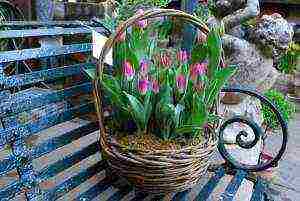
Tulip cultivation results
The essence of this method is that the bulbs are cooled without potting mix for nine weeks before planting. The maximum holding time of the bulbs before planting in the ground is twelve weeks.
If a florist wants to achieve flowering of a tulip for the New Year or Christmas, then you need to lay the bulbs for stratification no later than the beginning of September. At this time, the garden centers have a huge selection of bulbs.
It is in September or October that bulbs, including tulips, are planted in open ground. After that, they hibernate and wait for warm days.
At home, wintering occurs at an accelerated pace. The bulbs are immediately placed in a cold place and artificial winter sets in.
After 9-12 weeks of this content, depending on the variety and the period of forcing, the bulbs are planted in the ground.
Further, the bulbs begin to take root. For three weeks, containers with plantings must be kept at a temperature of 10-12 ° C. This can be a heated greenhouse near the house or a glassed-in balcony.
As soon as a sprout emerges from the bulb, the temperature should be raised to 20 ° C.
About a month after the emergence of the sprout, the tulip should bloom. Flowering lasts about a week. The use of additional stimulants such as HB-101 extends this period to two weeks.
- Cooling at 9 ° C.
With this method, the bulbs are immediately planted in boxes or pots. Together with the soil, they are cooled at 9 ° C. In this case, rooting occurs simultaneously with stratification or cooling.
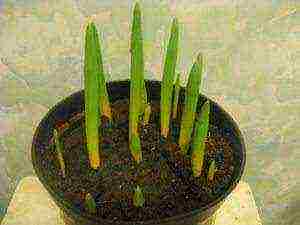
The first shoots of tulips in a pot
Shoots appear in three months. After that, the containers with plantings are brought into a warm room with a temperature of 18 ° C. The forcing period using this method is ten days shorter. Tulips should bloom 20 days after sprouting.
Each method has its own pros and cons. Many growers use the "nine-degree" method:
- Almost all tulip varieties are suitable for such a distillation.
- You can calculate the flowering period
- Constant temperature for almost the entire growing period
- When forcing in a heated greenhouse, less heating costs
The good thing about the “five-degree method” is that the period from the start of cooling to flowering is about four months.
When using the "nine-degree" method, this period is extended for 5 months.
The choice of forcing method is often determined by the presence or absence of conditions.
Where and what to buy for forcing bulbs
Forcing bulbs can be purchased:
- In the online store
- In the garden center
- From private collectors, florists
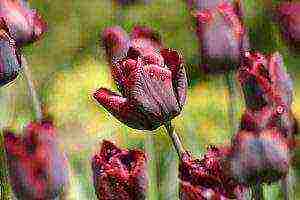
One of the varieties of tulips
Bulbs sourced from Holland have proven themselves best. Now such planting material is quite affordable and is of good quality.
You need to be very careful when choosing a company specializing in the sale of bulbs.
Planting material intended for forcing cannot be distinguished from ordinary bulbs.
Many unscrupulous sellers take advantage of this fact and sell them under the guise of "distillers".
Such flowers are unsuitable for a bouquet:
- View faded
- Flowers like paper
- The stem is pulled out
A flower grower, unaware that he is being deceived, finds out about this only at the last stage.
Having spent a lot of effort and a lot of money, you can get ordinary red tulips instead of the declared white giant tulips.
At this time, there are many information resources where you can learn about a particular company. This must be done in advance.
To obtain good large flowers, you need to purchase "extra" bulbs. The circumference of such a bulb must be at least 12 cm in its maximum diameter.
The correct choice of planting material is already half the success. The rest depends on the grower and his desire to achieve a good result.
Selection of varieties
The assortment of forcing tulips is constantly growing. Previously, only classic varieties were distilled.
Now almost any varieties and species can be grown in artificial conditions. There are nuances when growing fringed varieties:
- Fabio. A red flower with a yellow fringe, about 1 cm long.

Mass distillation of tulips
- Honeimun. The flower is pure white. The fringed border of the largest flowers is 7 mm or more.
- Starfighter. A red flower with a white fluffy border.
- Hughes Ten Bosch. A large flower of delicate pink color is decorated with a white fringe.
- Valery Gergiev. A glass of juicy red color. The flower is large with a fringe of about 1 cm.
- Lambada. A flower of a peach color, unusual for tulips, decorated with a golden fringe. It is not very wide, but thanks to the interesting combination of colors, the tulip looks luxurious.
These highly effective varieties require longer refrigeration. The forcing period is also extended.
When processing with growth stimulants and during the entire growing period, it is necessary to maintain a constant temperature of air and soil in the container.
Temperature fluctuations cause the stems to stretch and weaken. The quality of the flowers deteriorates.
There are more reliable types of tulips. They can be found in groups:
- Darwin hybrids
- Triumph
- Simple early
Tulips of the Triumph class or Russian giants for distillation enjoy increased success. They are slightly inferior to the fringed and parrot varieties in terms of the showiness of flowers.
By choosing reliable varieties, you can be sure of success.
Triumph class:
- Garden Party. The flower is pure white with red longitudinal stripes of the usual characteristic shape.
- Beauty of Apeldorf. Juicy cheerful orange color and delicate slightly rounded petals distinguish this variety from other members of the family.
- Alexander Pushkin. The dark cherry blossom is decorated with a white border around the edges. The shape of the flower is rounded, and looks more like a ball than a cone.
Class Russian giants:
- Ermak. A large flower with a strong and strong stem, sun-yellow in color.
- Pyotr Stolypin. Despite the large size of the flower, the pure and delicate white tulip seems airy.
- Catherine the Great. A rich pink flower along the edges gradually turns into a lighter one.
- Soul of Russia. A huge peach-colored glass with a slight blush.
Variegated flowers of the Parrot class stand out as a separate class:
- Super Parrott. A flower of white or milky color with green strokes really looks like a disheveled parrot.
- Black Parrott. The burgundy petals are fringed at the ends and resemble the wings of an outlandish bird.
The choice of varieties is huge.To gain experience and decide on the best, you need to try to grow different varieties from different classes. This is the only way to learn about the complexity or ease of growing.
Soil preparation and planting containers

Tulip growth stages
There are some rules for growing tulips at home:
Maintaining a constant temperature. This condition must be observed at different stages of cultivation. Swings and fluctuations are bad for the condition of the flower.
Additional lighting after sprouting. The source of additional lighting can be either a special phytolamp or an ordinary daylight lamp.
The forcing vessel should be deep, but not very wide. The ratio of the diameter of the pot to its height is 3: 5. This is necessary for the development of the roots. A well-formed root system will subsequently give a large and beautiful flower.
Loose, moisture-permeable soil. Potting soil for forcing tulips can be purchased ready-made in garden centers. You can take a simple land for conifers. You can increase the nutritional value of this mixture by adding compost or vermicompost to it.
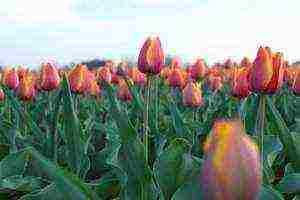
Blooming tulips
Self-cooking will take some time. To do this, you need to mix garden soil, sand, peat and humus in a ratio of 1: 1: 2: 2.
Vermiculite can be used instead of sand to loosen the soil. This will improve the quality of the soil mixture and retain moisture. The ground should not be too greasy.
Drainage. At the bottom of the planting container or box, it is imperative to pour drainage with a layer of at least 5 cm.
It is better to use fine expanded clay, coarse sand, pieces of coal, and fine gravel as drainage.
Maintaining constant soil and air moisture. It is impossible to fill the flower, but it is dangerous to dry out the earthen lump. Watering is carried out with settled water at room temperature once every two days.
Compliance with these rules is the second half of success. Patience and desire will surely lead to a result that will overwhelm the grower and brighten the gray winter days.
Have you noticed a mistake? Select it and press Ctrl + Enter to tell us.
Tulips
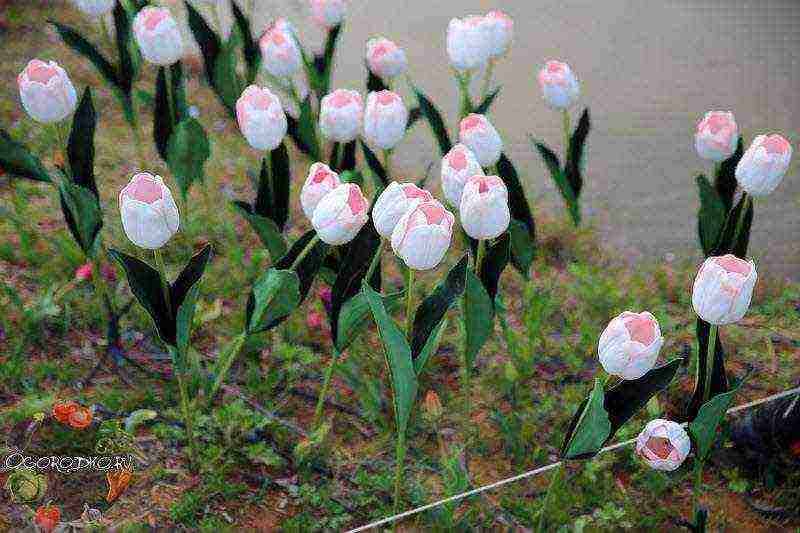
It is impossible to enumerate tulip varieties, there are an incredible variety of them - double late, fringed, undersized, peony, Dutch, for forcing and growing in a greenhouse - each of them will delight with their flowering, if the plant is properly cared for ...
Tulip varieties - New Dutch
![]() The tulip has long become a symbol of Holland - every year breeders present fresh varieties of Dutch tulips, although more than 2.5 thousand of them have already been bred in the Netherlands alone, and experienced gardeners have already got acquainted with the latest novelties:
The tulip has long become a symbol of Holland - every year breeders present fresh varieties of Dutch tulips, although more than 2.5 thousand of them have already been bred in the Netherlands alone, and experienced gardeners have already got acquainted with the latest novelties:
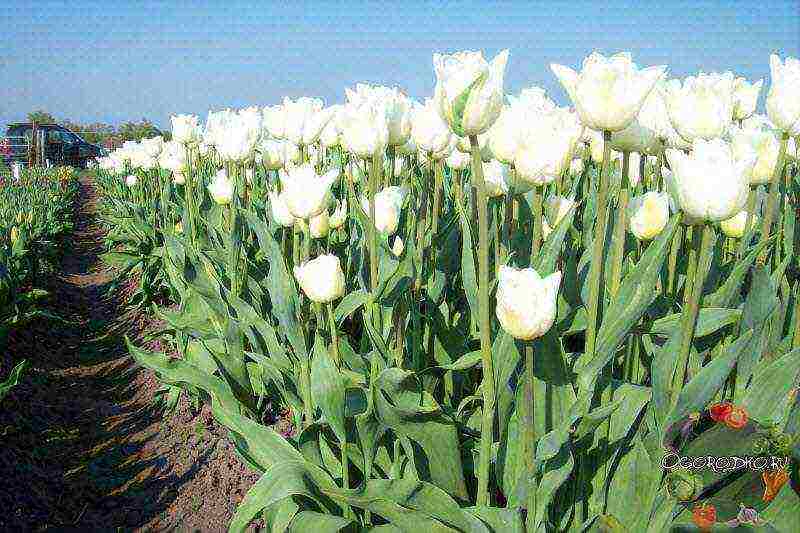 |
Albatross - snow-white, with a large graceful head, strong stem and dense leaves; |
 |
Beauty Trend - goblet, white, with a pink border, the stem reaches 70 cm; |
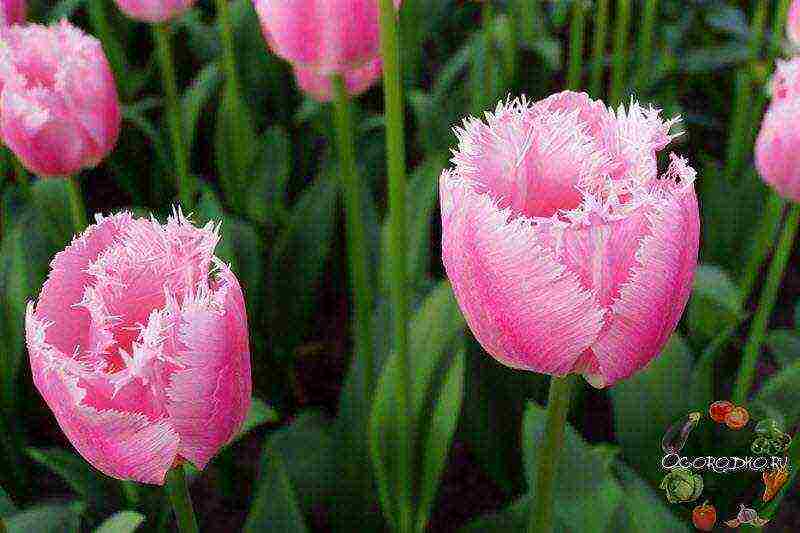 |
Casharel - intense pink glass with fringed edges; |
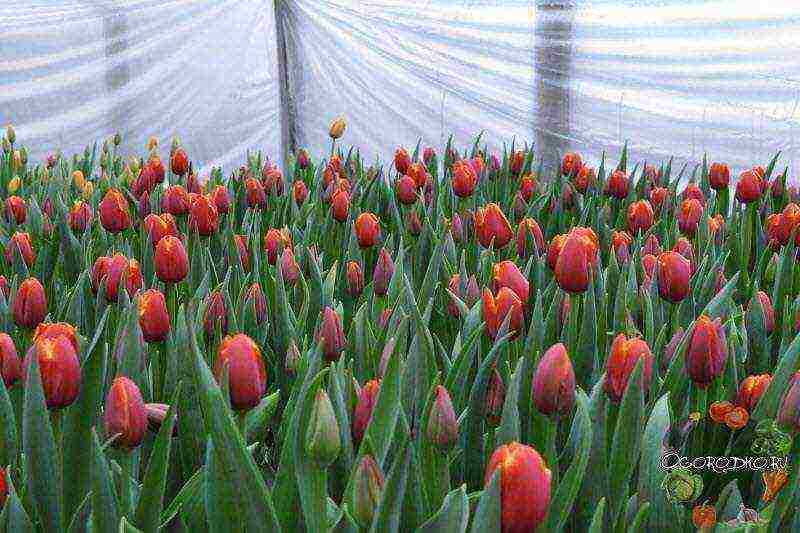 |
Verandi - harmoniously combines tomato red and sunny yellow tones with sharp transitions, the stem grows up to 55 cm. |
Ideal for forcing varieties - Darwin hybrids and Triumph
Tulips can bloom not only in spring, but in any month for the holiday, if they are grown according to the rules in a greenhouse or even at home - this method of growing is called forcing, and only special varieties of tulips can be successfully grown in this way.
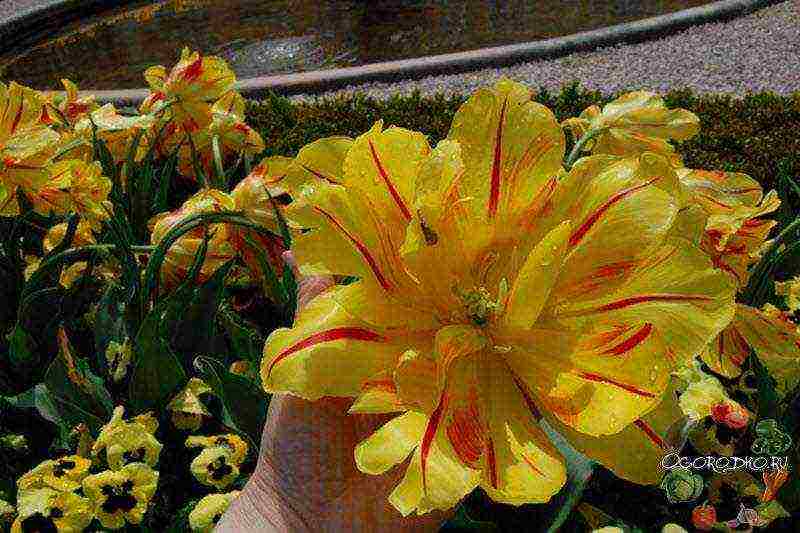
tulips for distillation
For distillation, medium-flowering plants are optimal, first of all, of two classes - Darwin hybrids and Triumph:
Representatives of Darwin hybrids - goblet, impressive in size, with a diameter of more than 10 cm, on an 80-centimeter leg, - they open wide in the sun, like poppies, usually in red tones, but there are also two-color specimens;
Tulips Triumph have a goblet flower shape, can reach a height of 80 cm, as for color schemes, all colors and shades are present in the color palette of this class of tulips, with the exception of blue.
It is also worth highlighting the varieties of tulips for forcing in the greenhouse:
- Diplomat - bright pink with a blue-white center, the stem reaches 50-60 cm;
- Vivex - a large reddish-orange with yellow edges, elongated bud with a strong peduncle that does not open in the light;
Traditionally used for forcing tulip varieties Parade, Keys Nelis, Eric Hofsier.
Fringed tulips
Fringed tulips, varieties and varieties of which appeared in Holland in the 30s of the XX century, got their name for the needle-like outgrowths along the edges of the petals, forming a fringe - they resembled a predatory plant sundew, this is how the name Sandyu is translated - the very first variety of this class, but recently, their multi-flowered varieties have also appeared:
The varieties of some fringed tulips are similar to lily-colored ones, in which three triangular inner petals are combined with reed outer ones - these are canary yellow Laverok, lemon Hamilton and others.
Double tulips - early and late varieties
Terry varieties are early and late. Early double tulips are undersized, their height does not exceed 30 cm, bloom at the end of April and delight the eye for a long time - they are planted in containers, they are excellent for forcing:
Late double tulips keep you waiting - they begin to bloom only in the second half of May. They are called pion-shaped, as they are sometimes indistinguishable from peonies - these luxurious creatures serve as a precious decoration of flower beds.
Terry late varieties show a variety of colors - from snowy white to very dark, there are also extremely expressive two-tone varieties. All of them look great on the alleys of parks and gardens:
Spectacular varieties of this class are Virosa, Charmin Lady, Sunlaver, Black Hirow, Negritta Double, Blue Diamond, Orange Angelica, Ankle Tom Bonanza.
White peony tulips look especially airy - these are Mount Tacoma, Casablanca, Maureen Double, Denslane.
Low-growing tulips or dwarf
Dwarf varieties are distinguished by unprecedented endurance, they are not afraid of cold weather, drought, wind - they are the first to decorate flower beds, you can also use them for forcing. Dwarfs, whose height is no more than 10 cm, are varied in color - from pure white to dark purple, but they are especially striking in the variety of purple tones, among them there are pink, bright crimson, purple, carmine, cherry.
Low-growing tulips are diverse in shape - they can be double, lily-shaped, multi-flowered, and among the best varieties are:
Tulip varieties such as Rembrandt tulips, as if stained by the artist's brush, will become real treasures of your garden:
The world collection of varieties is constantly growing, and flowers are becoming more and more like works of art.
